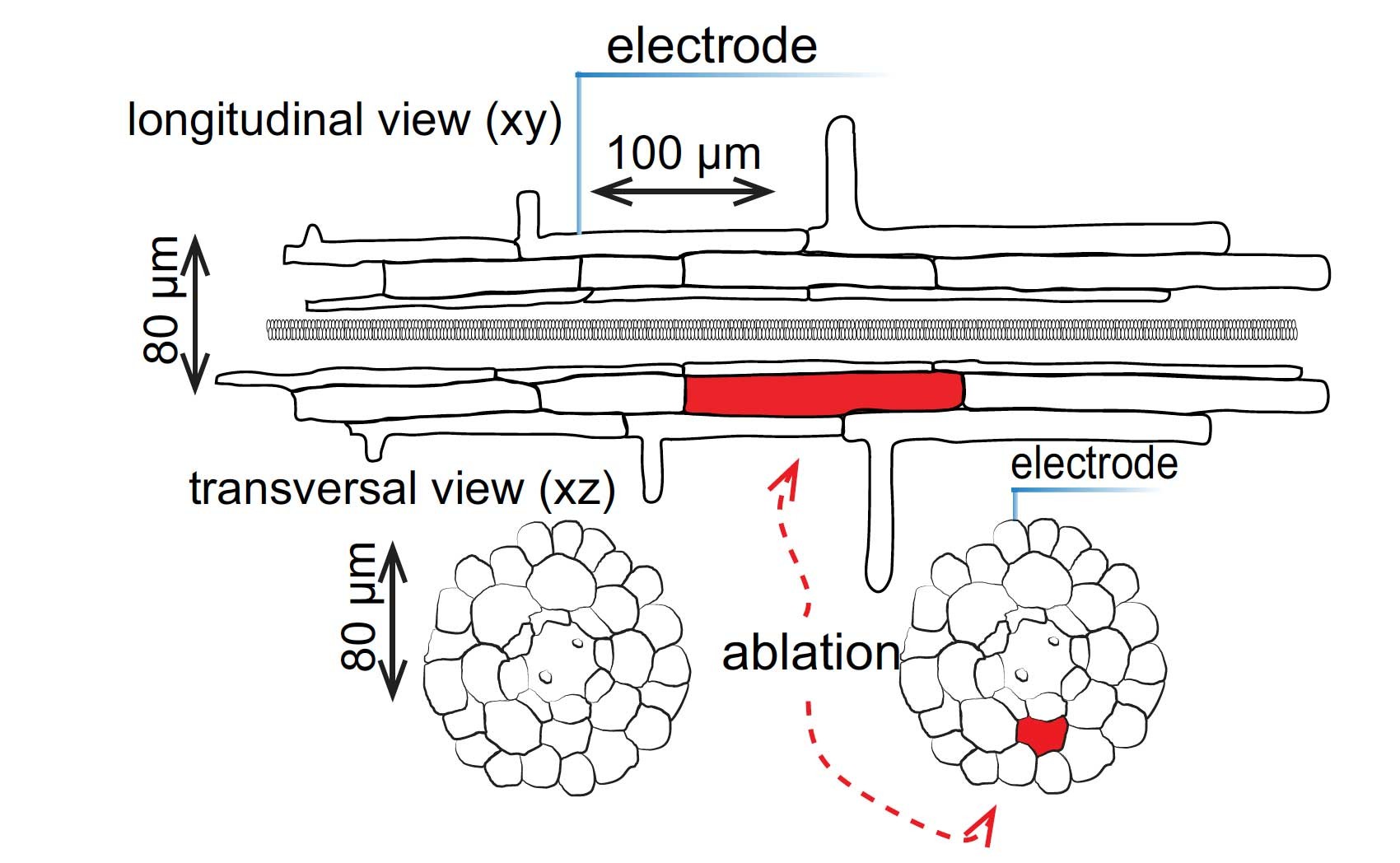博文
The EMBO Journal:拟南芥根组织单个细胞损伤诱导乙烯响应通路
||
Single‐cell damage elicits regional, nematode‐restricting ethylene responses in roots
First author: Peter Marhavy; Affiliations: University of Lausanne (洛桑大学): Lausanne, Switzerland
Corresponding author: Niko Geldner
Plants are exposed to cellular damage by mechanical stresses, herbivore feeding, or invading microbes. Primary wound responses are communicated to neighboring and distal tissues by mobile signals. In leaves, crushing of large cell populations activates a long‐distance signal, causing jasmonate production in distal organs. This is mediated by a cation channel‐mediated depolarization wave and is associated with cytosolic Ca2+ transient currents. Here, we report that much more restricted, single‐cell wounding in roots by laser ablation elicits non‐systemic, regional surface potential changes, calcium waves, and reactive oxygen species (ROS) production. Surprisingly, laser ablation does not induce a robust jasmonate response, but regionally activates ethylene production and ethylene‐response markers. This ethylene activation depends on calcium channel activities distinct from those in leaves, as well as a specific set of NADPH oxidases. Intriguingly, nematode attack elicits very similar responses, including membrane depolarization and regional upregulation of ethylene markers. Moreover, ethylene signaling antagonizes nematode feeding, delaying initial syncytial‐phase establishment. Regional signals caused by single‐cell wounding thus appear to constitute a relevant root immune response against small invaders.
植物容易受到机械胁迫、食草动物啃噬或微生物入侵所造成的细胞损伤。通过移动信号,植物的损伤响应能够传递到邻近和远端的组织。在叶片中,同时损伤一大类细胞会激活长距离信号转导,诱导远端组织产生茉莉酸。该过程是由阳离子通道介导的去极化波所介导的,与细胞质中的钙离子瞬间流量相关。本文,作者报道了通过激光烧蚀损伤根中的单个细胞诱导了非系统性、区域化的表面电位改变,钙离子波动以及活性氧物质的产生。令人惊讶的是,激光烧蚀并不会诱导茉莉酸的响应,反而会激活区域化的乙烯产生和乙烯响应标记。乙烯激活依赖于钙离子通道活性,与叶片中的机制不同,并且具有特异性的NADPH氧化酶。有趣的是,线虫的侵染会诱导非常类似的响应,包括膜的去极化和区域化的乙烯标记上调。此外,乙烯信号会拮抗线虫啃食,从而延缓线虫侵染初始阶段的建立。由单个细胞损伤诱导的区域化信号似乎是针对小的侵染者而存在的根免疫响应。
Background
解析由入侵生物攻击而发生的分子事件是非常困难的,因为模式识别事件和损伤感知之间的交互作用十分复杂,同时还要考虑由侵染者引起的寄主细胞生理改变和免疫响应。因此,理解植物单独对于物理损伤的响应是非常重要的。植物细胞报告损伤的分子,如细胞壁片段化和细胞释放ATP、胞质多肽等细胞内的因子被认为是植物细胞完整性受到损伤的标志(Choi et al, 2014; Duran-Flores & Heil, 2016)。尽管最近有研究报道细胞内的谷氨酸可能是报道细胞损伤的核心因子(Toyota et al, 2018),然而这些释放出来的细胞因子大多时候并不足以再次产生实际物理损伤时所诱导的响应。
现行施以物理损伤的办法通常会摧毁一大类的细胞群,从而影响了目的器官中绝大多数的细胞类型(Mousavi et al, 2013; Toyota et al, 2018)。这种办法有利于研究目的器官对于其它器官的系统预警信号,但并不适用于解析目的器官中不同细胞类型的混杂响应。另外,这种方法只能模拟体型较大的昆虫或食草动物对于植物的损伤刺激,并不能很好的反应小昆虫、线虫或者死体营养型微生物侵染植物过程中造成的损伤响应。因此,本文作者开创性的利用激光烧蚀的方法损伤单个细胞,从而区别于以往所采用的方法研究植物损伤感知的基础机制。
目前,我们可以高分辨率、高精度地活体观察和处理拟南芥幼苗的根。这种技术在细胞生物学、嘎鱼和激素感知等研究中广泛应用(Benfey & Scheres, 2000),而在植物与病原菌互作以及植物防御响应等方面的应用则欠缺。这不仅导致我们对于根中的防御响应不如叶片中那样理解透测,同时还错失了利用根作为植物防御反应机制研究模型的机会。
近些年,有关根微生物组学的研究突飞猛进,人们对于更加复杂的根-生物互作过程中根的防御响应机制越来越感兴趣(Hacquard et al, 2017)。在最近的合作研究中,作者构建了一系列的防御响应标记株系,包含响应于主要胁迫和防御响应通路的启动子和一个NLS 3X mVenus融合蛋白,具有高度敏感性和细胞类型特异性的信号输出(Poncini et al, 2017)。综合这些前期研究基础,以及作者之前参考van den Berg等人1997年在根中建立的单个细胞激光烧蚀的方法(Marhavy et al, 2016),作者在本文中研究了根对于单个细胞层次损伤的响应机制。
Reference
Choi J, Tanaka K, Cao Y, Qi Y, Qiu J, Liang Y, Lee SY, Stacey G (2014) Identification of a plant receptor for extracellular ATP. Science 343: 290 – 294
Duran-Flores D, Heil M (2016) Sources of specificity in plant damaged-self recognition. Curr Opin Plant Biol 32: 77 – 87
Toyota M, Spencer D, Sawai-Toyota S, Jiaqi W, Zhang T, Koo AJ, Howe GA, Gilroy S (2018) Glutamate triggers long-distance, calcium-based plant defense signaling. Science 361: 1112 – 1115
Mousavi SAR, Chauvin A, Pascaud F, Kellenberger S, Farmer EE (2013) GLUTAMATE RECEPTOR-LIKE genes mediate leaf-to-leaf wound signalling. Nature 500: 422 – 426
Benfey PN, Scheres B (2000) Root development. Curr Biol 10: R813 – R815
Hacquard S, Spaepen S, Garrido-Oter R, Schulze-Lefert P (2017) Interplay between innate immunity and the plant microbiota. Annu Rev Phytopathol 55: 565 – 589
Poncini L, Wyrsch I, Dénervaud Tendon V, Vorley T, Boller T, Geldner N, Métraux J-P, Lehmann S (2017) In roots of Arabidopsis thaliana, the damageassociated molecular pattern AtPep1 is a stronger elicitor of immune signalling than flg22 or the chitin heptamer. PLoS One 12: e0185808
van den Berg C, Willemsen V, Hendriks G, Weisbeek P, Scheres B (1997) Short-range control of cell differentiation in the Arabidopsis root meristem. Nature 390: 287 – 289
Marhavy P, Montesinos JC, Abuzeineh A, Van Damme D, Vermeer JEM, Duclercq J, Rakusová H, Nováková P, Friml J, Geldner N et al (2016) Targeted cell elimination reveals an auxin-
通讯:Niko Geldner(http://wp.unil.ch/geldnerlab/lab-members/current/)
个人简介:1998年,图宾根大学,学士;1998-2003年,图宾根大学,博士。
研究方向:植物内皮层极性建立;内皮层栓化。
doi: 10.15252/embj.2018100972
Journal: The EMBO Journal
Published online: May 05, 2019
https://blog.sciencenet.cn/blog-3158122-1177857.html
上一篇:Nature Biotechnology:NRT1.1B作用于籼、粳稻大田条件下的根际微生物组成与氮利用效率差异
下一篇:the plant journal:植物陆地化过程中香豆酰共轭体系3-羟化酶的演化
全部作者的其他最新博文
- • Plant Physiology:CsMADS3促进柑果中的叶绿素降解和类胡萝卜素合成(华中农业大学)
- • Molecular Plant:LBD11-ROS反馈调节作用于拟南芥的维管形成层增殖和次生生长(浦项科技大学)
- • Science Advances:根结线虫通过调控植物的CLE3-CLV1模块,促进侵染进程(日本熊本大学)
- • Nature Communications:油菜素内酯参与植物营养生长期转变的分子机制解析(浙江农林大学)
- • Current Biology:光合作用产生的蔗糖驱动侧根“生物钟”(德国弗莱堡大学)
- • PNAS:花同源异型基因在叶中被抑制、花中被激活的分子机制(南卡罗来纳大学)

